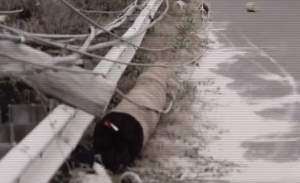Verizon’s Test Of Landline-Less Service Leaves Some Customers Out In Cold

Verizon’s old copper wire network didn’t weather Hurricane Sandy very well, but is the replacement actually worse?
On New York’s Fire Island, Verizon has replaced copper wire service with a wireless-based option called Voice Link. Verizon is hoping that this test will help to convince the FCC that Voice Link is an acceptable replacement for landline service, as that would save the company a huge amount of money in maintenance of its copper wire network, which has seen a huge drop-off in use with the rise of cellular phones and voice-over-Internet services that use cable lines.
But there appear to be some problems, especially on Fire Island, which doesn’t have any cable service. Thus, businesses and residents have relied on Verizon’s landline network not just for their phone service, but also for Internet access and other services. Some residents who have switched over to the Voice Link service say that it is not a suitable replacement for landlines, as it does not provide dependable service and does not support things like faxes, credit card machines, remote medical monitoring devices, or home alarm systems.
One local restaurant owner tells CBS 2 in NYC that his employees can no longer swipe credit cards the way he used to before Voice Link.
“I had to have my waiters write down the credit-card number, the expiration number and the CVV (security) code,” he explains. “It took me over three and a half hours to process all my credit cards on Saturday. That’s pretty ridiculous.”
The mayor of Fire Island describes the quality of Voice Link service as “sketchy, to say the least.”
It’s not just the New York coast that has complaints about Voice Link. Yesterday, officials in Sullivan County, along the northeastern Pennsylvania border, issued a public statement about their concerns regarding the system.
“[P]roducts like Voice Link are an insult and a danger to our community,” said one local official.
A few weeks back, New York State Attorney General Eric Schneiderman filed an emergency petition with state regulators to stop Verizon from replacing copper lines with alternatives in the Catskill Mountains of upstate New York. He claims that Verizon has been pushing customers with summer homes to accept Voice Link as a replacement.
Back in June, Bruce Kushnick of the New Networks Institute described Voice Link in a very unflattering light:
Voice Link is like a cell phone from a decade ago — before there was ‘data’. Voice Link is a box put into the home with an antenna, but it can not do almost any data application that is part of the traditional utility-based phone network, commonly called the “PSTN”, Public Switched Telephone Networks, or sometimes referred to as “POTS”, Plain Old Telephone Service….
FYI: If you had Voice Link you couldn’t read this online because it doesn’t support DSL or even dial-up internet via a modem attached to a regular POTS phone line.
In general, Verizon says that it can’t feasibly replace copper networks when fewer and fewer customers use them.
“If we fixed the copper, there’s a good likelihood people wouldn’t even use it,” a rep tells CBS.
The question is where do you draw the line between Verizon’s cost efficiency and providing a service to the public? In terms of replacing copper wire, Voice Link simply doesn’t allow users to have access to all the services and communications devices the old network did. So what about replacing copper with fiber?
“Everybody would love for us to put in fiber, but that’s just not practical,” says the Verizon rep.
Want more consumer news? Visit our parent organization, Consumer Reports, for the latest on scams, recalls, and other consumer issues.

